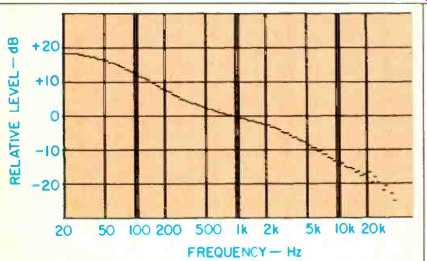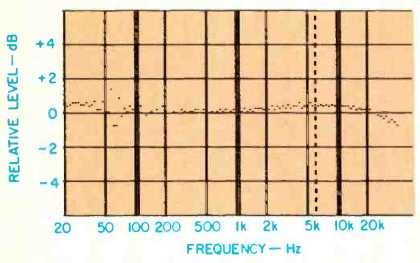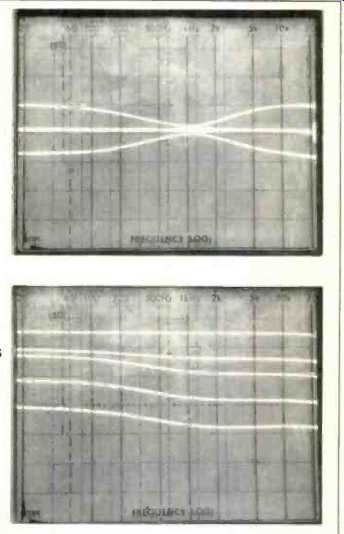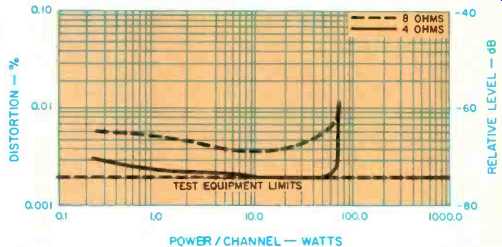
SU-A8 Control Amplifier:
Manufacturer's Specifications:
Frequency Response: MM phono, RIAA ±0.2 dB; MC phono, RIAA ±0.5 dB; high level, d.c. to 20 kHz, -0.2 dB.
Maximum Output Voltage: High level, 10 V.
Rated Output Voltage: 1.0 V (150 mV at record-out jacks).
THD: MM phono, 0.003%; MC phono, 0.01%; high level, 0.002%.
Input Sensitivity for 0.5-V Out: MM phono, 1.25 mV; MC phono, 85 µV; high level, 75 mV.
S/N Ratio: MM phono, 79 dB; MC phono, 75 dB; high level, 100 dB. Maximum Phono Input Voltage: MM, 150 mV; MC, 10 mV. Phono Input Impedance, MM/MC: 47 kilohms/220 ohms.
Main Output Impedance: 2 ohms.
Tone Control Range: ± 10 dB at 50 Hz (bass) and 20 kHz (treble).
Subsonic Filter: 12 dB/octave below 20 Hz.
Loudness Control (Volume at -30 dB): +9 dB at 50 Hz.
Power Consumption: 15 watts.
Dimensions: 17 in. (43.18 cm) W x 2 3/32 in. (5.32 cm) H x 14 3/8 in. (36.51 cm) D.
Weight: 9.9 lbs. (4.45 kg).
Price: $350.00.
SE-A7 Power Amplifier:
Manufacturer's Specifications:
Rated Power Output: 60 watts per channel, 8- or 4-ohm loads, 20 Hz to 20 kHz (120 watts in mono mode).
Rated THD: 0.003% at 8 ohms, 0.007% at 4 ohms or mono.
Dynamic Headroom: 1.5 dB.
SMPTE IM Distortion: 0.003%, 8-ohm loads.
Damping Factor at 50 Hz: 100.
Frequency Response: 20 Hz to 20 kHz, +0,-0.1 dB.
Input Sensitivity: 130 mV.
Power Consumption: 316 watts.
Dimensions: 17 in. (43.18 cm) W x 23/32 in. ( 5:32 cm) H x 14 3/8 in. (36.51 cm) D.
Weight: 20.9 lbs. (9.405 kg).
Price: $500.00.
The SU-A8 control amp and SE-A7 matching power amp represent two-thirds of a new slimline series which Technics calls its Studio Collection. The remaining component, the ST-S8 frequency-synthesized tuner, is, like the units tested for this report, only a fraction over two inches high.
The SU-A8 is a preamplifier-control unit that employs d.c., Class A circuitry from input to output, and FET differential inputs in all stages for input capacitorless operation. The only coupling capacitor used in the entire signal path is at the phono equalizer output. A single-ended push-pull stage is used as the output amplifier of this unit, and the phono equalizer/preamp stage consists of low-noise dual FETs.
The circuitry of the matching SE-A7 power amplifier features Technics' version of dynamic output-stage biasing, which they term New Class A, as well as their innovative Linear Feedback circuit. An interesting new feature is called Auto Load detection. When the SE-A7 is coupled to loads of less than 6 ohms, for example, the amplifier automatically reduces the voltage supplied to the power supply at the power transformer level. This reduction in operating voltage limits the heat buildup that might otherwise occur when driving multiple speaker systems or low-impedance loads.
The front panel of the SU-A8 preamp has a power switch at its extreme left, near which is what appears to be the outline of a door. This door defied my attempts to open it until I read the owner's manual and discovered that it's actually a motor-driven shelf and can therefore only be opened (or closed) when power is turned on and an adjacent control button depressed. With the shelf ejected, I gained access to slide controls for bass, treble and channel balance functions, a loudness on/off switch, and a subsonic filter switch. Those audio purists who shun tone controls and other signal-processing circuitry need never open the little shelf (perhaps that's why Technics took such pains to "hide" these secondary controls inside it) and can, in fact, bypass the tone controls entirely by setting a nearby operation selection button to "Straight DC." A tape/source button and a tape 1/tape 2 button are to the right of the operation selector, followed by three larger pushbuttons for tape monitor and program selection (MM or MC phono and tuner or AUX, selected as alternate pairs). Tiny lights above this group let the user know which functions or program sources have been selected. Still further to the right is a slide control button which is moved horizontally to adjust volume level. As the slider is pushed to the right, a volume-level scale illuminates to indicate relative levels selected. Finally, at the extreme right is a button labeled "Fader" which, when depressed, smoothly fades volume down to barely audible levels for telephone-answering or other listening interruptions. I must agree that this fader's action is a lot more elegant than the abrupt muting switch normally supplied for this purpose. To restore full volume, the fader is simply touched a second time. While the primary goal of any piece of audio equipment must be good sound reproduction, there's no harm in lending a touch of elegance, and Technics has certainly done that with their motorized tone-control "drawer" and smooth fader switch.
The rear panel of the SU-A8 is equipped with the usual pairs of input and tape output jacks, three a.c. convenience outlets, and two pairs of output terminals. One output pair is d.c.-coupled, while the other is intended for connection to non-d.c. power amplifiers.
Turning to the layout of the matching SE-A7 amplifier, we find that it is aesthetically almost identical to the control unit.
The power switch is at the left, and adjacent to it is a headphone jack. Three buttons near panel-center handle main or remote speaker selection and peak-power indicator range (times 1 or times 0.01). Further to the right, illuminated indicators tell which speakers are engaged, whether mono operation has been selected (via a rear-panel switch), and what power range has been chosen for the peak-power LED indicators (which occupy the right-most section of the front panel). Having a hundred-fold increase in sensitivity of these indicators enables the user to utilize them meaningfully, even when listening at background music levels.
A pair of input jacks are at the left of the rear panel, and the mono/stereo switch is next to them. Color-coded speaker terminals are of a new type which I have seen only a few times before. The plastic terminal is turned counterclockwise, and the stripped end of a speaker wire is inserted in a hole in the rotatable plastic cap, which is then turned clockwise to "lock" the wire in place. With the speaker wires stripped the proper amount, it's just about impossible to cause a short between them. A single unswitched convenience outlet completes the rear-panel layout.
Control Amplifier Measurements

Fig. 1--RIAA playback characteristic, Technics SU-A8 preamplifier.

Fig. 2--Expanded plot using inverse RIAA test signal shows deviation from
RIAA response, SU-A8 preamplifier.
Input sensitivity for the moving-magnet phono inputs measured 1.1 mV for the standard referenced 0.5-V output at 1 kHz, while the signal level required for that same output for the MC phono was 75 µV. High-level inputs took a 66 mV input level to deliver 0.5-V standard output. Phono overload (maximum input) was 165 mV for the MM inputs and 11 mV for the high-gain MC inputs. These figures are slightly better than those claimed. Figure 1 is a plot of amplitude versus frequency via the phono inputs and shows the familiar RIAA playback characteristic.
In Fig. 2, I used an inverse RIAA test signal and an expanded vertical scale (2 dB per division instead of 10 dB per division, as in Fig. 1) to show the departure from RIAA of the phono equalizer section. Worst-case deviation was +0.5 dB at 6 kHz, but since there were no negative deviations in the response curve, it would be fair to say that RIAA equalization was accurate to within ± 0.25 dB. Signal-to-noise ratio for the moving-magnet phono inputs was an incredibly high 90 dB-about as high a number as I have ever obtained for a phono preamp input referenced to 5-mV input and 0.5-V output levels. Even the moving-coil inputs, which normally do not yield as good a signal-to-noise ratio as the lower-gain MM inputs, yielded a S/N of 78 dB, which I consider to be excellent. Remember that in accordance with the new amp measurement standards used for this test, the 78 dB figure is referenced to a mere 0.5-mV input and 0.5-V output. High-level inputs showed signal-to-noise ratios of 91 dB, while residual noise (with volume control at minimum) was 95 dB below 0.5-V output. The subsonic filter was slightly mistuned in that it rolled off response to -3 dB at 30 Hz instead of at 20 Hz as claimed. Maximum output of the control amplifier (before noticeable clipping) was 11.0 volts as against 10.0 volts claimed. Tone control range and loudness control action are depicted in Figs. 3 and 4. Note that this loudness control circuit boosts bass frequencies only. I have always maintained that this is the preferred approach to non-continuously variable loudness circuits.

Fig. 3--Range of bass and treble controls, Technics SU-A8.
Fig. 4--Action of loudness control at various settings of master volume control on Technics SU-A8.

Fig. 5--Power output vs. THD, Technics SE-A7 amplifier.
Power Amplifier Measurements
Technics notes in their spec sheet for the SE-A7 that it was necessary to use a spectrum analyzer to measure the low residual harmonic distortion levels it produced. For all but a few extreme measurements my test equipment was not up to the task of measuring THD either (the signal source itself contains 0.002% THD at most test frequencies). Nevertheless, I put together as good a graphic plot of distortion versus power output as I could, using my distortion analyzer and a spectrum analyzer, where necessary, and the results are shown in Fig. 5 for both 8and 4-ohm loads. Normally, I would have drawn separate curves for 1 kHz, 20 Hz and 20 kHz power vs. distortion, but in this case, distortion at the frequency extremes is so close to the distortion observed at mid-frequencies that all three lines (six, if you try to combine 4and 8-ohm operation) would have fallen on top of each other, or very nearly so.
Of perhaps more practical use is the fact that the amplifier delivered just under 75 watts into 8-ohm loads before noticeably clipping, and precisely 100 watts per channel with 4-ohm loads for the same degree of clipping. Twin-tone CCIF IM measured 0.0009%, while IHF IM, usually somewhat higher, measured exactly the same minuscule 0.0009%. Dynamic headroom was precisely 1.5 dB as claimed, and low-frequency damping factor measured 108, or a bit better than claimed by Technics. Input sensitivity for 1-watt.output was 130 mV; for rated output (60 watts per channel), 1.0 V of input signal was required. Slew factor was greater than 5-or beyond the limits of my test equipment. The A-weighted signal-to-noise ratio measured 116 dB below rated output. Frequency response extended way out to 100 kHz for a-1 dB roll-off and out to 200 kHz for a -3 dB roll-off.
Use and Listening Tests
The Technics SU-A8 and SE-A7 are ideally matched to each other, not only in size and cosmetics but in terms of performance, sound quality, and features. The preamp-control unit will appeal to both audio purists as well as those who want some control over the overall response of their equipment. In my use tests, I was somewhat perplexed by the fact that when I turned off the system and then turned it back on again, the previously selected program source had to be punched in again. I consulted the owner's manual and found that this quirk only occurred because my tests were of such short duration. Normally, when power is plugged in and the system is used for more than one hour, the last selected source (high-level or phono, tuner or AUX) will come on again for as long as a week later! With the SE-A7 as companion amplifier, I was able to use the d.c. output jacks on the SU-A8. In doing so, however, I would advise others to choose a turntable system that exhibits low rumble content. Otherwise, you may find it necessary to operate the system as an a.c.-coupled pair of units or, in more extreme cases, with the subsonic filter turned on. That would tend to defeat all the trouble that Technics went to in creating a true d.c. system, from the high-level preamp inputs to the speaker outputs.
It wasn't too long ago that sophisticated separate components of this sort were the province of a very few small manufacturers who, because of their limited production runs, charged outrageously high prices for such "purist" components. It's nice to be able to obtain a combination of components such as the SU-A8 and SE-A7 for well under $1,000.00, thanks to the purchasing, design and production power of a giant company like the Technics Division of Panasonic, which is, of course, a division of the even bigger Matsushita Electric Company.
As for the sound quality of this combination, it was simply superb. Highs were open and transparent, while bass was as tight as you would want it. With the SU-A8 and SE-A7 as the nucleus of your sound system, your main concern will be finding speakers and program material that's good enough for these components.
-Leonard Feldman
(adapted from: Audio magazine, May 1982)
Also see:
Technics SA-GX910 A/V Receiver (Equip. Profile, July 1992)
= = = =